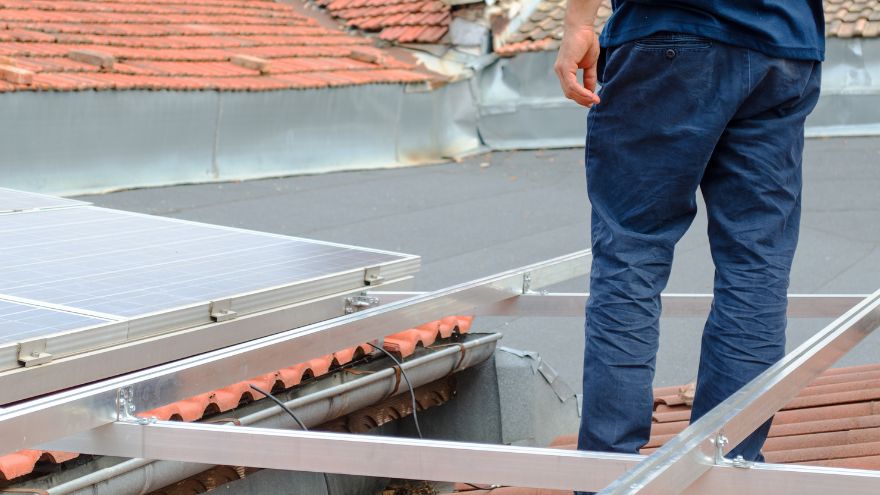In order for photovoltaic panels to serve well, producing free electricity, they must be properly mounted. This is crucial regardless of whether the installation is on the roof or on the ground. The most important thing is to match such construction systems that ensure the stability of the panels, as well as optimal working conditions. In the following article, we will look at these issues, explaining how to choose the right ground structure for photovoltaics. We will also present the selection of photovoltaic panel mounting systems depending on the roof pitch. We will also look at another important issue regarding the mounting of inverters in photovoltaic installations.

Check out the PV mounting structures at the Onninen wholesaler
How to choose the right ground structure for photovoltaics?
Photovoltaics , which allows you to obtain free energy from the sun, has become a permanent part of the landscape of our local towns. It can be installed either on the roof or on the ground. The choice often falls on the latter, especially if we have such a place on our plot.
 The structure should be ideally suited to various factors, such as the type of ground, weather conditions or the specifics of the terrain. In the case of stable, hard ground, traditional driven systems work perfectly. They are easy to install and relatively cheap. If the ground is more demanding (e.g. sandy or clayey), it is better to choose screwed structures. They provide better stability and resistance to ground settlement.
The structure should be ideally suited to various factors, such as the type of ground, weather conditions or the specifics of the terrain. In the case of stable, hard ground, traditional driven systems work perfectly. They are easy to install and relatively cheap. If the ground is more demanding (e.g. sandy or clayey), it is better to choose screwed structures. They provide better stability and resistance to ground settlement.
The angle of the panels is also extremely important. Ground structures work very well here, providing flexible positioning of the modules in such a way as to make maximum use of sunlight. They can be perfectly adjusted. The optimal angle is usually between 25° and 35°. It is also worth knowing that in open areas that are exposed to strong winds, investing in reinforced systems is a good idea. They effectively prevent the installation from tipping over or being damaged. PV panels on this type of structure are a good solution both for large installations (for example, photovoltaic farms) and for property owners who cannot or do not want to install them on the roof.
Selection of photovoltaic panel mounting systems depending on the roof slope
 PV mounting structures must take into account a number of different factors. One of the most important is the roof pitch. It largely determines the chosen mounting system for photovoltaic panels. On flat roofs, support structures with adjustable tilt angle are usually used. This allows for optimal positioning of the panels towards the sun. Considering this, it should be noted that ballast systems are quite a popular solution, as they eliminate the need to interfere with the roof surface. They provide stability thanks to the appropriate load.
PV mounting structures must take into account a number of different factors. One of the most important is the roof pitch. It largely determines the chosen mounting system for photovoltaic panels. On flat roofs, support structures with adjustable tilt angle are usually used. This allows for optimal positioning of the panels towards the sun. Considering this, it should be noted that ballast systems are quite a popular solution, as they eliminate the need to interfere with the roof surface. They provide stability thanks to the appropriate load.
Pitched roofs are a slightly different category, so the fasteners must be adapted to the type of roofing to avoid damage while maintaining the tightness of the roof. In the case of trapezoidal sheet metal roofs, special rails and brackets are ideal, which can be mounted directly to the supporting structure. On tiled roofs, roof hooks are recommended, allowing for safe fastening under the roofing layer.
Mounting inverters in photovoltaic installations
The inverter is, next to the photovoltaic panels, the most important element of the entire installation, referred to as the heart of the system. It is no coincidence that its role is so crucial that it requires appropriate mounting and location to ensure effective and trouble-free operation. When choosing a mounting location, we must consider several key aspects, especially thermal conditions, ventilation and protection against moisture. In most cases, inverters are mounted on the walls of the building or in technical rooms, dry, well-ventilated and shielded from direct sunlight.
 For outdoor installations, it is extremely important to use weatherproof mountings and choose inverters with the appropriate IP protection level. They provide tightness and resistance to dust and water. When it comes to indoor installation, we should simply avoid places that are exposed to high humidity (e.g. basements).
For outdoor installations, it is extremely important to use weatherproof mountings and choose inverters with the appropriate IP protection level. They provide tightness and resistance to dust and water. When it comes to indoor installation, we should simply avoid places that are exposed to high humidity (e.g. basements).
Equally important, inverters must be mounted in such a way that they have adequate airflow (around the device). This will avoid drops in efficiency and overheating. When it comes to larger installations, where there are several inverters, it is recommended to use special technical cabinets that additionally protect them.
Photovoltaic panels provide free, clean energy, but for this to happen, they must be properly mounted. The solutions described in the article will work in the vast majority of cases!
Check out the PV mounting structures at the Onninen wholesaler